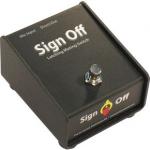Why do I need to become a member?
How do I become a member?
Send me straight to the membership form.
Switches

Lapel microphones usually need to be turned on and off many times during a service. They tend to interfere with the main microphones and generally cause unwanted noise when not in use. The receiver usually does not get along well with computer generated electrostatic noise and the mixer it feeds into has too many knobs to be run by a layman. Asking the pastor to turn on and off the wireless microphone generally ends up in disaster. What do you do?
You use an inline audio switch. These can be either active or passive and are easy to build. The main thing an audio switch does is to switch only the audio and not the DC level, that way you have no pops or unwanted noise.
Commercial audio switches
 Some commercial audio switches list for over $100. Amazing how high the price can go for specialty items. The DIY's below have under $20 of list price parts.
Some commercial audio switches list for over $100. Amazing how high the price can go for specialty items. The DIY's below have under $20 of list price parts.
Building your own passive audio switch.
Note: These circuits use bipolar electrolytic capacitors, so remember your eye protection. (This may seem a little paranoid, but I had a big one explode in my face when I was a kid.)
Sources:
Rick's Audio Switch Notes: For PIC computer control, but would also be great for remote switching.
Discover Circuit's Pop Free Mic Switch: This "will work on dynamic and electret type microphones". It doesn't say anything about "Line Level" equipment or "phantom power" condenser microphones. Shorting "Line Level" to ground is a scary thought and for safety sake, use at least a 50V capacitor before trying this circuit with 48V "phantom power".
My own simple gizmo:
input □───┤├───┬───┘ ────┬───┤├───□ output
10μF │ switch │ 10μF
50V │ │ 50V
┌┴┐ ┌┴┐
100K│ │ │ │100K
└┬┘ └┬┘
│ │
input □────────┴──────────┴────────□ output
(gnd) (gnd)
Operation: The capacitors discard the DC levels as the audio portion enters the circuit. The inner DC levels are kept near 0 because of the resistors. Only audio is switched, so no pops.
Note1: The capacitors are 50V because some systems have all inputs charged with 48V "phantom power" for powering condenser microphones. Remember the DC level is discarded, so condenser microphones won't work.
Note2: For a remote application, a reed relay could be used in parallel with the switch. This way, if you use a battery to power the reed relay, it will only drain the battery when the switch is 'on'. Keeping the manual switch in the circuit will allow it to be turned 'on' permanently in case of a dead battery. Think simplicity.
- Login to post comments
